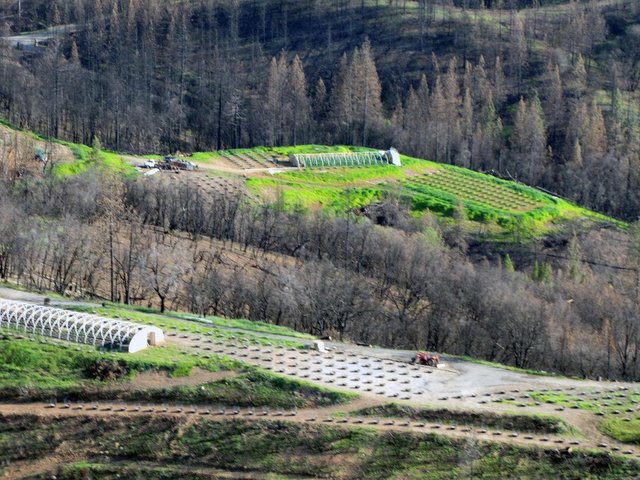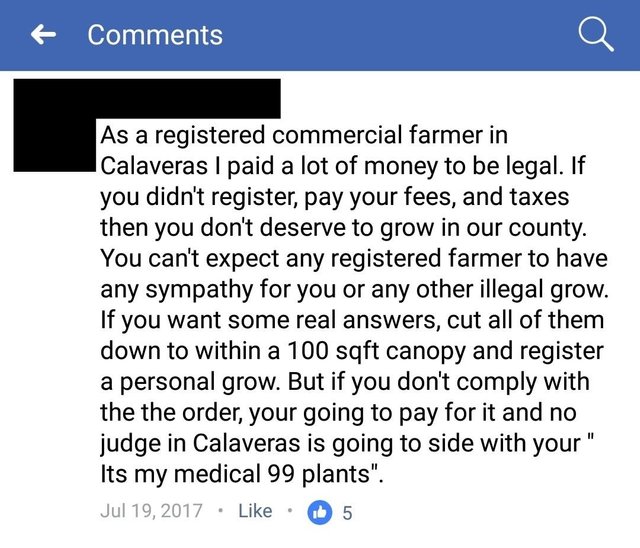CA Cannabis bans: Fear & Loathing in Calaveras County.

Calaveras County Board of Supervisors vote to ban commercial cannabis cultivation.
Original photo credit: Enterprise photo by Jason Cowan
Original Edit by thesouthface
January 10, 2018: CALAVERAS COUNTY, CA has joined a growing number of counties around the State that have moved to outright ban commercial cannabis cultivation since the passage of Proposition 64 by voters on November 8, 2016. The 3-2 decision by the county Board of Supervisors stands to affect about 200 County compliant growers, and many others who have already applied for permits who are now expected to completely abate operations within 90 days of the ban taking affect on February 9, 2018.

Enterprise photo by Mike Taylor
The saga of legal cannabis in Calaveras County is long, and contentious.
In a 4-1 decision on May 10, 2016 the Calaveras County Board of Supervisors enacted a temporary Urgency Ordinance to regulate their local cannabis industry, and place a cap on new farms entering the legal market. Proponents of the Ordinance lauded the bolstering effects a legal industry could have in the rebuilding of their economy after the Butte fire, but these sentiments were swiftly contradicted by their assertion that it could also be utilized to stem the influx of new grower's purchasing cheap land from desperate property owners left devastated in the fires wake. A move that would likely stifle the economic growth they were so vehemently arguing in favor of, and that highlights the true nature of regulation advocates across the state.
The Urgency Ordinance set an annual fee schedule of $5000 per commercial cultivation operation, $200 for caregivers, and $100 for personal grows, as well as canopy size limitations for each licensing tier. Further, it instated building, and environment regulations that caused applicants to incur tens of thousands, and up to hundreds of thousands of dollars in addition costs to bring their operations into legal compliance. The Ordinance also dictated that only current property owners with already existing gardens could enter the program, and only if they applied by June 30, 2016. Of the County's roughly 45,000 residents, about 700 growers initially applied for the program, with 503 applications still having yet to be processed throughout the time the Urgency Ordinance was active.
November 8, 2016 saw the voter passage of Calaveras County Measure C. The measure levied additional annual taxes on canopy size of $2 per square foot for outdoor-grown cannabis, and $5 per square foot for indoor-grown cannabis. Taxes of $45 per pound for outdoor-grown cannabis flowers, and $70 per pound for indoor-grown cannabis flowers would also be assessed upon the roll out of the State track-and-trace systems, as well as a 7% gross proceeds tax on cannabis manufacturing, and retail sales. Measure D, also on the November ballot, would have enacted a permanent framework for commercial cultivation, but was defeated by voters in the County.

Legal medicinal patient enduring County penalty in lue of State compliance: Original screenshot & Edit for posters anonymity by thesouthface
In light of the steep barriers to entry placed on Calaveras County's legal industry, many growers in the area elected not to enter the County's temporary commercial cultivation program. Those who did not comply were met with strict enforcement, though many of them were still technically legal under current State medicinal laws that allow patients to posses and cultivate quantities consistent with their doctor's recommendation, even in cases where it exceeds mandated personal limits. These protections were initially implemented with the passage of Proposition 215 in 1996, but were recodified in Proposition 64, and further solidified in SB 94 enacted through the State Legislature on June 15, 2017.
The rift this created within the cannabis community ran deep. Taxes, and fees collected from Calaveras County's regulatory programs where set to go directly back into compliance enforcement. Many growers who had invested in complying with the county program turned openly hostel toward what they preserved as their “illegal” counter parts, and cried out in vitriol for greater enforcement on those outside of their highly-regulated market. In spite of the newly implemented ban, Calaveras County officials have vowed to enforce collections of nearly $1 million in unpaid cannabis fines incurred from “illegal grows”. The fines were mainly levied against otherwise legal growers who either failed, or refused to come into compliance with the County's strict regulatory scheme.


Example of the overwhelming attitude of Registered Growers in Calaveras County toward their legally medicinal counter-parts: Original screenshot & Edit for posters anonymity by thesouthface
In the shocking turn of events that transpired last Wednesday, regulation advocates in Calaveras County have had their once championed Urgency Ordinance ripped out from under them. The enforcement apparatus they so gleefully funded, and cheerfully utilized to berate and terrorize their peers, will likely be weilded against them if they fail, or refuse to comply with the County Board's decision.
Since the enactment of the Urgency Ordinance, Calaveras County has collected roughly $3.7 million in permit fees, and an additional $5 million in cultivation taxes. The decision to ban is expected to trigger lawsuits from growers for the recouping of costs, and damages they incurred through compliance with the temporary program. Grower’s attempts at litigation will likely be met with stark opposition from the County. On November 25, 2016, according to then incoming County supervisor Dennis Mills, the participants of the program agreed to a release of liability upon filing, which would protect the municipality from legal action in the event of a future policy change. At the suggestion of County supervisor Mike Oliveira, after the Board of Supervisors vote on January 10, 2018, the final decision on the matter may be presented to County residents on the June 2018 ballot.